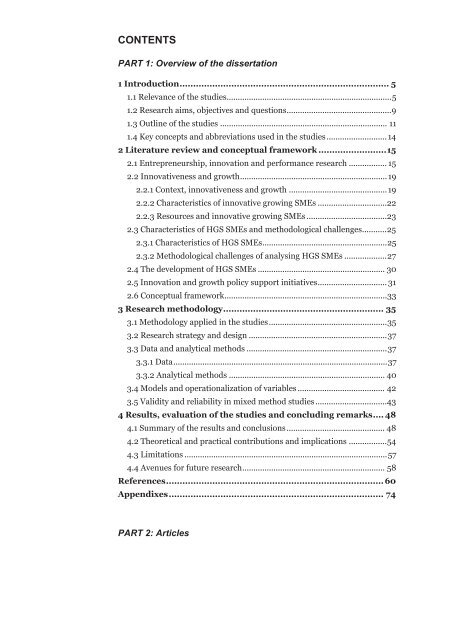dissertation in pdf-format - Aalto-yliopisto
dissertation in pdf-format - Aalto-yliopisto
dissertation in pdf-format - Aalto-yliopisto
Create successful ePaper yourself
Turn your PDF publications into a flip-book with our unique Google optimized e-Paper software.
CONTENTS<br />
PART 1: Overview of the <strong>dissertation</strong><br />
1 Introduction ............................................................................. 5<br />
1.1 Relevance of the studies .......................................................................... 5<br />
1.2 Research aims, objectives and questions ............................................... 9<br />
1.3 Outl<strong>in</strong>e of the studies ........................................................................... 11<br />
1.4 Key concepts and abbreviations used <strong>in</strong> the studies ........................... 14<br />
2 Literature review and conceptual framework ......................... 15<br />
2.1 Entrepreneurship, <strong>in</strong>novation and performance research ................. 15<br />
2.2 Innovativeness and growth .................................................................. 19<br />
2.2.1 Context, <strong>in</strong>novativeness and growth ............................................ 19<br />
2.2.2 Characteristics of <strong>in</strong>novative grow<strong>in</strong>g SMEs ...............................22<br />
2.2.3 Resources and <strong>in</strong>novative grow<strong>in</strong>g SMEs .................................... 23<br />
2.3 Characteristics of HGS SMEs and methodological challenges ........... 25<br />
2.3.1 Characteristics of HGS SMEs ........................................................ 25<br />
2.3.2 Methodological challenges of analys<strong>in</strong>g HGS SMEs ................... 27<br />
2.4 The development of HGS SMEs ......................................................... 30<br />
2.5 Innovation and growth policy support <strong>in</strong>itiatives ............................... 31<br />
2.6 Conceptual framework ......................................................................... 33<br />
3 Research methodology ........................................................... 35<br />
3.1 Methodology applied <strong>in</strong> the studies ..................................................... 35<br />
3.2 Research strategy and design .............................................................. 37<br />
3.3 Data and analytical methods ............................................................... 37<br />
3.3.1 Data ................................................................................................ 37<br />
3.3.2 Analytical methods ...................................................................... 40<br />
3.4 Models and operationalization of variables ....................................... 42<br />
3.5 Validity and reliability <strong>in</strong> mixed method studies ................................43<br />
4 Results, evaluation of the studies and conclud<strong>in</strong>g remarks .... 48<br />
4.1 Summary of the results and conclusions ............................................ 48<br />
4.2 Theoretical and practical contributions and implications ................. 54<br />
4.3 Limitations ........................................................................................... 57<br />
4.4 Avenues for future research ................................................................ 58<br />
References ................................................................................ 60<br />
Appendixes ............................................................................... 74<br />
PART 2: Articles
















